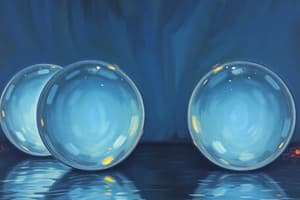Podcast
Questions and Answers
What happens to the wavelength of light as its frequency increases?
What happens to the wavelength of light as its frequency increases?
- Wavelength increases
- Wavelength becomes irrelevant
- Wavelength decreases (correct)
- Wavelength remains constant
Which law describes how light reflects off a surface?
Which law describes how light reflects off a surface?
- Law of refraction
- Law of diffraction
- Law of dispersion
- Law of reflection (correct)
Which equation would you use to find the relationship between original and image heights in mirror calculations?
Which equation would you use to find the relationship between original and image heights in mirror calculations?
- $h_o/h_i = d_i/d_o$
- $h_i - h_o = d_i imes d_o$
- $h_i/h_o = d_i/d_o$ (correct)
- $h_i + h_o = d_i + d_o$
What occurs during total internal reflection?
What occurs during total internal reflection?
Which type of lens is thicker at the center than at the edges?
Which type of lens is thicker at the center than at the edges?
Flashcards
Refraction
Refraction
The bending of light as it passes from one medium to another. For example, light bending as it enters water from air.
Index of Refraction (n)
Index of Refraction (n)
The ability of a material to bend light. It's the ratio of the speed of light in a vacuum to the speed of light in that material.
Critical Angle
Critical Angle
A point beyond which a ray of light cannot be refracted (bent) back into the original medium. This occurs when light moves from a denser medium to a less dense medium.
Normal
Normal
Signup and view all the flashcards
Converging Lens
Converging Lens
Signup and view all the flashcards
Study Notes
Optics
- Light is a wave
- Properties of a wave (wavelength, amplitude, frequency)
- Electromagnetic spectrum
- Types of energy (radio, micro, visible light, x-rays, etc)
- Relationship between wavelength and frequency
- Ray model of light
- Law of reflection
- Types of reflection (2)
- All Mirrors
- Image characteristics in the 3 mirrors studied in all situations where the object is relative to the mirror (SALT)
- Ray diagrams for all 3 mirrors
- Ray diagrams used to create virtual images
- Practical uses of the 3 types of mirrors studied
- Magnification equation (hi/ho = di/do)
- Refraction
- Predicting whether a refracted ray will bend towards or away from the normal.
- Index of refraction (n=c/v)
- Snell's Law
- Critical angle/total internal reflection
- Applications of refraction in the real world
- Lenses
- Identifying lenses based on shape and refracted rays
- Image characteristics for both lenses (SALT) - DO NOT MIX WITH MIRRORS!!
- Ray diagrams for both lenses, all situations
- Real-life applications of lenses
Studying That Suits You
Use AI to generate personalized quizzes and flashcards to suit your learning preferences.




